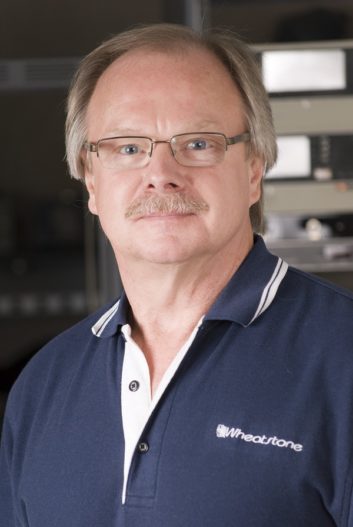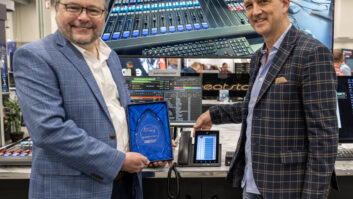
Jeff Keith is senior audio processing product development engineer for Wheatstone Corp. This is one in a series of interviews from the ebook “Trends in Audio Processing for Radio.”
Radio World: Jeff, what would you say the most important development in processors?
Jeff Keith: The radio broadcast medium is in the process of reinventing itself. While over-the-air radio is still important, especially with the ability of HD to simultaneously carry multiple program types, technology now makes the delivery of other information not just a fad but the soon-to-be norm.
I can see a time where those huge broadcast towers we’ve seen for many decades are all but gone, and replaced by high-speed internet or cellular technology — technology that will allow listeners to carry their favorite programs and stations not just out of the local market, but to anywhere in the world.
RW: What should readers know about the differences in processing needs for various platforms?
Keith: Each transmission medium requires different audio processing treatment in order to deliver the best quality audio to the listener.
I’ve seen many stations that are still using retired on-air processing for their internet stream, or worse yet, feeding the internet stream encoder from the output of a radio or modulation monitor. I can’t think of a better way to make a nasty sounding internet stream!
Purpose-built streaming processing will always sonically outperform any other form of processing not specifically designed for streaming codecs.
RW: How will the concepts of the cloud, virtualization and software as a service affect the processing marketplace?
Keith: There is no question that it is possible to run anything software-based, including audio processing, on cloud servers. It’ll be awhile before we see the end of this movie, though — how broadcasters will handle redundancy, encryption and failover to an alternate when the main goes offline.
Software as a service will be the norm, and I can see a time when radio stations will no longer “own” their audio processing, at least in the form of today’s hardware box. Audio processing will be a chunk of software running on a cloud server somewhere and licensed by instance, probably annually, on a recurring schedule.
The whole game will be different.
RW: With audio originating from so many locations, what role do loudness and loudness range play?
Keith: It is my personal wish that the United States would adopt some form of over-the-air loudness regulation.
Listen to stations in countries where they need to adhere to ITU BS.412, for instance. Those stations are much more pleasant to listen to because the processing hasn’t been tuned to the singular goal of “louder than everyone else on the planet.”
I think many stations have forgotten that it isn’t loudness, it’s program content. Every radio made in the last 100 years has had a volume control …
RW: What recently introduced new features or capabilities in processors are most notable?
Keith: Nielsen’s PPM audio software encoder embedded in processing is significant because it’s a step closer to cloud and virtualization, and we’ve been working with their development team to make that happen. Our X5 FM/HD processor now has the PPM encoder inside.
It’s worth noting that broadcasters are looking for much more quality out of their processors, and this is why we recently came out with our MP-532 multipurpose audio processor that can be used for FM, AM, FM HD, or AM HD. It’s a very practical processor that has all our latest distortion canceling algorithms and lookahead limiters and I don’t mind saying it sounds amazing. I didn’t mean for this to turn into a shameless plug, but you did ask!
RW: In 2014 we wrote that processors were so powerful that it was hard to imagine further dramatic improvements. How do you answer today?
Keith: We’ve made tremendous strides since 2014 (and in the past 20 or so years), and I think algorithms will continue to improve. Over time developers have learned more about what people prefer to hear and how subtle differences can make or break the perception of what is “good” processing.
We’ve also learned more about masking distortion from the ear and what we can get away with as far as different forms of distortion. Evolution will continue, processing will continue to get smarter, and the availability of wickedly powerful hardware will enable us to do things that were only imagined five years ago.
Oops, did I say hardware? Remember … what you have “running in the cloud” is actually running on somebody’s hardware.
RW: One expert says, “My perspective is that radio processing already attained a condition of ‘hypercompression’ years ago and there has been little further change in how loud one can make over-the-air audio.” Do you accept that, and how do we break out of that plateau in the loudness wars?
Keith: My goal, and I suspect that of most audio processor designers, has been to deliver to broadcasters a new processor that can be as loud on the air as their previous processor was, but be much cleaner while generating that same loudness.
Unfortunately, what most stations do is crank the new processor up until the distortion is back to about where it was before … and now they’re 2 dB louder than before.
Don’t be a wimpy station on the air but there’s no need to blast listeners out of their car, either.
RW: We understand AES loudness metrics are moving to a lower target level for content, streams, podcasts and on-demand file transfer, like metrics already established for online and over-the-top video. If radio stays with the current environment of modulation limiting, reception noise and lingering loudness wars, could radio see loss of audience due to listening fatigue?
Keith: Loudness wars only seem to serve the egos of the individual stations, and I’m not aware of any research showing that louder wins even when the program content is poor.
I do agree, however, that a loud signal helps overcome noise. And I’ll also agree that we should carefully manage the audio so that listeners aren’t lunging for the volume control every time a new song comes along.
Listeners should get a smooth and comfortable ride with our station’s audio; and the better and more pleasant that ride is — accompanied by something worth listening to, of course — the longer they are going to listen.
As professional people who have dedicated ourselves to this industry to perform our art, we intuitively know what can turn listeners off; and yet sometimes we still do it. Puzzling.
RW: We read about how processing can mitigate FM stereo multipath distortion and reduce clipping distortion in source content. How can equipment buyers evaluate such claims, and could there be some kind of third-party scientific testing?
Keith: The problem with evaluating anything that’s not actually running in the field is that it’s not actually running in the field, i.e., lab tests can only show what things do under lab conditions.
Stereo multipath mitigation is a good example, and one must understand that it is receiver behavior that needs to be modified.
The technique that Wheatstone uses is something that I designed back in the ’90s for solving a different problem; mono loudness when airing ping-pong stereo recordings (oldies). It cured that problem very nicely but it also had a greater-than-expected effect on multipath on most stereo radios. Customers have reported similar findings in the field and while it doesn’t help everyone, it appears to help most.
RW: What’s your take on the demo from Nautel and Telos to eliminate alignment issues by locking the FM and HD1 outputs from the processor through the HD air chain to the transmitter?
Keith: Great idea, and extremely similar in function to the SyncLink product Wheatstone demonstrated at NAB 2017. A guaranteed way to preserve FM/HD synchronization over an IP STL is to ensure that the two audio signals always look like one signal to the link. That way, even if packets are dropped the two signals can never get out of sync.
We also recognized that not every station can afford shiny new state-of-the-art transmitters so we designed SyncLink to be compatible with every single FM transmitter and exciter ever made.







